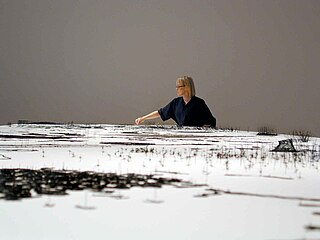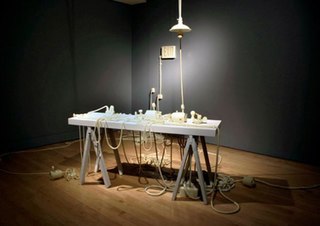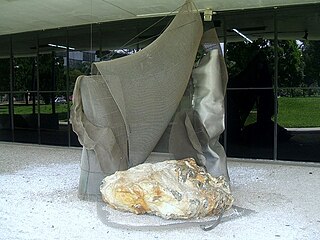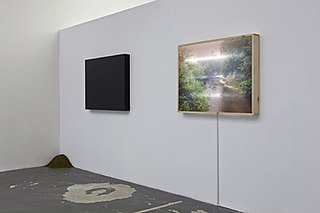Related Research Articles
Sarah Lucas is an English artist. She is part of the generation of Young British Artists who emerged in 1988. Her works frequently employ visual puns and bawdy humour by incorporating photography, sculpture, collage and found objects.

Eva Hesse was a German-born American sculptor known for her pioneering work in materials such as latex, fiberglass, and plastics. She is one of the artists who ushered in the postminimal art movement in the 1960s.
Jessica Jackson Hutchins is an American artist from Chicago, Illinois who is based in Portland, Oregon. Her practice consists of large scale ceramics, multi-media installations, assemblage, and paintings all of which utilize found objects such as old furniture, ceramics, worn out clothes, and newspaper clippings. She is most recognizable for her sloppy craft assemblages of furniture and ceramics. Her work was selected for the 2010: Whitney Biennial, featured in major art collections, and has been exhibited throughout the United States and internationally, in Iceland, the UK, and Germany.

Isa Genzken is a German artist who lives and works in Berlin. Her primary media are sculpture and installation, using a wide variety of materials, including concrete, plaster, wood and textile. She also works with photography, video, film and collage.

Carol Bove is an American artist based in New York City. She lives and works in Brooklyn.

Alice Anderson is a French artist who studied at the École Nationale Supérieure des Beaux-Arts of Paris and Goldsmiths University of London. Associated with the performance Art movement Anderson works primarily with technological objects. She creates paintings by dancing with VR masks, laptops, drones, mobile phones, printers, speakers and sculptures by using an eco-friendly copper-coloured wire symbolising neuronal and technological connections of the internet debut.

Anne Wilson is a Chicago-based visual artist. Wilson creates sculpture, drawings, Internet projects, photography, performance, and DVD stop motion animations employing table linens, bed sheets, human hair, lace, thread and wire. Her work extends the traditional processes of fiber art to other media. Wilson is a professor in the Department of Fiber and Material Studies at The School of the Art Institute of Chicago.

Jessica Stockholder is a Canadian-American artist known for site-specific installation works and sculptures that are often described as "paintings in space." She came to prominence in the early 1990s with monumental works that challenged boundaries between artwork and display environment as well as between pictorial and physical experience. Her art often presents a "barrage" of bold colors, textures and everyday objects, incorporating floors, walls and ceilings and sometimes spilling out of exhibition sites. Critics suggest that her work is informed by diverse artistic traditions, including abstract expressionism, color field painting, minimalism and Pop art. Since her early career, they have noted in her work an openness to spontaneity, accident and marginality and a rejection of permanency, monetization and disciplinary conventions that Stephen Westfall characterized as an "almost shocking sense of freedom."

Jeanne Silverthorne is an American sculptor, known for cast-rubber sculptures and installations that explore the artist's studio as a metaphor for artistic practice, the human body and psyche, and mortality. She gained prominence in New York City in the 1990s, as one of several material-focused sculptors who critiqued the austere, male-dominated Minimalist movement by embracing humble, unorthodox media and hand-made, personal and ephemeral qualities championed by artists such as Eva Hesse and Louise Bourgeois. She treats the studio as a physical and conceptual site to be excavated, documented and inventoried, examining in the words of Sculpture's Jan Riley "the end of studio arts … and the impossibility of this mode of expression regaining its former creative validity and vitality in today’s world." Art in America critic Raphael Rubinstein wrote that, like the late studio paintings of Philip Guston, Silverthorne examines "deeply melancholic realms, enlivened by the occasional mordant joke, in which lowly objects are relentlessly and lovingly queried for a meaning they never seem quite ready to yield."

Leslie Hewitt is an American contemporary visual artist.

Haegue Yang is a South Korean artist primarily working in sculpture and installation. After receiving her B.F.A from Seoul National University in 1994, Yang received an M.A. from Städelschule where she now teaches as a professor of Fine Arts. She currently lives and works in Berlin and Seoul.
Liz Magor is a Canadian visual artist based in Vancouver. She is well known for her sculptures that address themes of history, shelter and survival through objects that reference still life, domesticity and wildlife. She often re-purposes domestic objects such as blankets and is known for using mold making techniques.

Maria Porges is an American artist and writer based in the San Francisco Bay Area. As an artist she is known for the prominent use of text in her visual works, which encompass sculpture, works on paper and assemblage and have an epistemological bent. As a critic Porges has written for Artforum, Art in America, Sculpture and SquareCylinder, among other publications.

Arlene Shechet is an American sculptor known for her inventive, gravity-defying arrangements and experimental use of diverse materials. Critics describe her work as both technical and intuitive, hybrid and polymorphous, freely mixing surfaces, finishes, styles and references to create visual paradoxes. Her abstract-figurative forms often function as metaphors for bodily experience and the human condition, touching upon imperfection and uncertainty with humor and pathos. New York Times critic Holland Cotter wrote that her career "has encompassed both more or less traditional ceramic pots and wildly experimental abstract forms: amoebalike, intestinal, spiky, sexual, historically referential and often displayed on fantastically inventive pedestals … this is some of the most imaginative American sculpture of the past 20 years."

Iole Antunes de Freitas is a Brazilian sculptor, engraver, and installation artist who works in the field of contemporary art. Freitas began her career in the 1970s, participating in a group of artists in Milan, Italy linked to Body art. She used photography. In the 1980s, she returned to Brazil, but abandoned the human body as mediator of her work, adopting the "sculpture body". The artist uses materials such as wire, canvas, steel, copper, stone, and water to create her works.
Leonor Antunes is a Portuguese contemporary artist who creates sculptural installations. She lives and works in Berlin.
Park McArthur is a conceptual artist living in New York City who works in sculpture, installation, text, and sound. McArthur is a wheelchair user whose work uses this position to inform her art.
Sabine Hornig is a German visual artist and photographer who lives and works in Berlin. Her work in photography, sculpture, and site-specific installation art is known for her interpretations of modernist architecture and contemporary urban life. Her work has appeared in solo exhibitions throughout the world, including Double Transparency at Art Unlimited Basel in Switzerland (2014) and Projects 78 at the Museum of Modern Art in New York (2003), and in numerous group exhibitions at institutions like the J.Paul Getty Museum in Los Angeles and ICA London.

Ginger Wolfe-Suarez is an American artist, writer, and curator who has worked out of Los Angeles, the San Francisco Bay Area, and Atlanta. Her practice includes installation art, sculpture, drawings, and artist books. She has been featured in exhibitions in Paris, Berlin, Vienna, and throughout the United States, at venues including Silverman Gallery, Luckman Fine Arts Complex, Southern Exposure, Berkeley Art Museum and Pacific Film Archive (BAMPFA), Yerba Buena Center for the Arts, and High Desert Test Sites. Her work has been reviewed in Artforum, the Los Angeles Times, San Francisco Chronicle, Sculpture, Art Papers and Art Practical, among other publications. Wolfe-Suarez draws on the traditions of feminist sculpture, Latin American installation art, conceptualism, and minimalism in works that function phenomenologically to explore the perception of space and materials, body-object relationships, ephemerality, and negotiations of memory. Artforum reviewer Annie Buckley described her show at Ltd Los Angeles as one in which "the cerebral [was] incidental to the sensory," with subtle images, fleeting reflections and lingering scents indicating the intangible.

Gloria Kisch (1941–2014) was an American artist and sculptor known especially for her early post-Minimalist paintings and wall sculptures, and her later large-scale work in metal.
References
- ↑ Ellegaard, Line. "Artists at Work: Alice Channer". Afterall. Afterall.
- ↑ Sherwin, Skye (15 April 2011). "Artist of the week 134: Alice Channer". The Guardian.
- ↑ Wright, Karen (14 March 2013). "In The Studio: Alice Channer, artist" . Independent. Independent. Archived from the original on 13 February 2016.
- ↑ Walsh, Brienne (14 May 2015). "Alice Channer". Art in America. Art in America.
- ↑ Channer, Alice. "500 Words". Artforum. Artforum.
- ↑ Thorne, Sam (March 2010). "Alice Channer". Frieze (129).
- ↑ Channer, Alice. "500 Words". Artforum. Artforum.